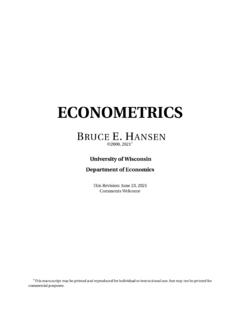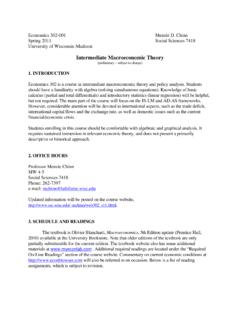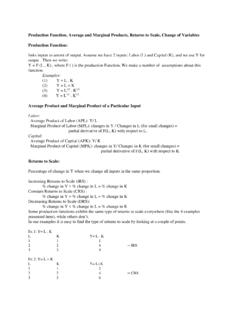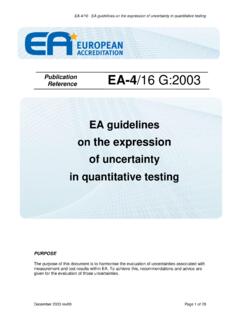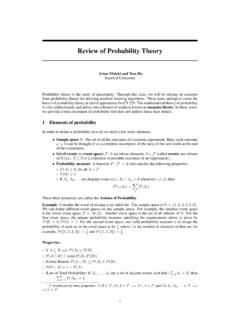Transcription of Lecture: Probability Distributions
1 Lecture: Probability Distributions Probability Distributions random variable - a numerical description of the outcome of an experiment. There are two types of random variables (1) discrete random variables can take on finite number or infinite sequence of values (2) continous random variables can take on any value in an interval or collection of intervals ex) The time that it takes to get to work in the morning is a continuous random variable. ex) The number of Bs. that you get in class this semester is a discrete random variable.
2 Discrete Random Variables Probability Function (PF) - is a function that returns the Probability of x for discrete random variables for continuous random variables it returns something else, but we will not discuss this now. ()fx The Probability density function describles the the Probability distribution of a random variable. If you have the PF then you know the Probability of observing any value of x. Requirements for discrete PFs. (1) ()0fx (2) ()1fx= Cumulative Distribution Function (CDF) ()Fx- is a function that returns the Probability that a random variableXis less than or equal to a value.
3 The distribution function has the same interpretation for discrete and continuous random variables. The CDF is also sometimes called the distribution function (DF). x Requirements for CDFs (1) everywhere the distribution is defined ()0Fx (2) non-decreasing everywhere the distribution is defined. ()Fx(3) as ()1Fx x 1 Example: Consider the Probability distribution of the number of Bs you will get this semester x ()fx ()Fx 0 2 3 4 Expected Value and Variance The expected value, or mean.
4 Of a random variable is a measure of central location. ()()Exxf x == In the formula above each value is weighted by Probability that it occurs. The expectation is essentially a weighted average. Some properties of expected values ()()EaxaExa = = where is a constant a ()()EaxbaExbab += += + where and b are constants a ()()()ExyExEy+=+ The variance is a measure of the variability of a random variable. ()22()()Var xxf x == Some properties of variance 22()()VarxEx = 2()()VaxaVarxa22 = = where is a constant a 2()()()EaxbaExbaVarxa22 += += = where and b are constants a ()()()2(,)()()(VarxyVarxVaryCovx yVarxyVarxVary+=++ +=+)if and xyare independent.
5 ()()()2(,)()()(VarxyVarxVaryCovx yVarxyVarxVary =+ =+)if and xyare independent Lets compute the expected value and variance of the number of Bs you will get this semester. ( )0 * * * * +++= 2 222( )( ) * ( ) * ( ) * ( ) * + + + =2 Some Common (and Useful) Discrete Probability Distributions Discrete Uniform Distribution ()1, where is the number of values that x can assumefxnn= Binomial Distribution Properties of a Binomial Experiment (1) The experiment consist of n identical trials (2) Two outcomes are possible on each trial success or failure (3) The Probability of success, denoted by p, does not chance from trial to trial.
6 (4) The trials are independent. Example: Flip a fair coin 4 times. What is the Probability that I get two tails? How many trials? Are two outcomes possible? Does the Probability of a tail change? Are the trials independent? Lets think about how we could compute this Probability The first thing that we need to do is think about how many ways I can get 2 tails in 4 flips TTHH THTH THHT HTTH HTHT HHTT There are 6 ways. Each way there is to get 2 tails has a Probability of occurring. This the Probability of getting exactly 2 flips in 4 trials is 22(1)PP 22( )6( ) ( )fx= 3 The Binomial PF: !
7 ()(1)!()!xnnfxppxnxx = Probability of each way actually happening The number of ways to get x successes out of n trials Example: Someone in the class play basketball? What was the free throw percentage? This will be your Probability of success. Suppose that we have you shoot 10 free throws. How many trials would we have here? 10 Are two outcomes possible on any trial? 2 Does the Probability of success chance from trial to trial? Maybe Are the trials independent? Maybe Using the formula for the binomial PF we can figure out the Probability of you making exactly 5 free throws assuming that the Probability of success does not change trial to trial and that the trials are 5510!
8 (5) ( ).0265!(105)!f= = For the binomial random variable ()Exnp= - this one is pretty intuitive ()(1)Var xnpp= - this one you are just going to have you believe me on. Example: Compute the expected number of made free throws and the variance of the number of made free throws 4 The Poisson Probability Distribution The Poisson Distribution describes the Probability of that x number events occur in an interval (time or space for example). Example: The number of job offers that an unemployed worker receives in a week might have a Poisson Distribution.
9 The number of defective parts that come off the assembly line per hour might also have a Poisson Distribution The number of Zs that we see per 60 miles of road might also have a Poisson Distribution. Properties of the Poisson Distribution (1) The Probability of occurrence is the same for any two intervals of equal length. (2) The occurrence or nonoccurrence in any interval is independent of the occurrence or nonoccurrence in any other interval. The Poisson PF: ()!xefxx = where ( )the expected number of events occuring in an intervalEx == and Example: An unemployed worker receives an average of two job offers per week.
10 What is the chance that he receives 4 offers in one week? 422(4)(4) !ePf == Example: On average we see 4 Zs. per 100 miles of road. What is the Probability of observing no Zs in a 100 mile stretch of highway? 044(0)(0) !ePf === What about a 3Zs in 50 mile stretch of highway? Because the Probability is the same over any two intervals of equal length and the Probability of the occurrence or nonoccurrence in any interval is independent of the occurrence or nonoccurrence in any other interval you can always calculate the Probability of x events-arrivals in by multiplying the mean be a factor of proportionality.



